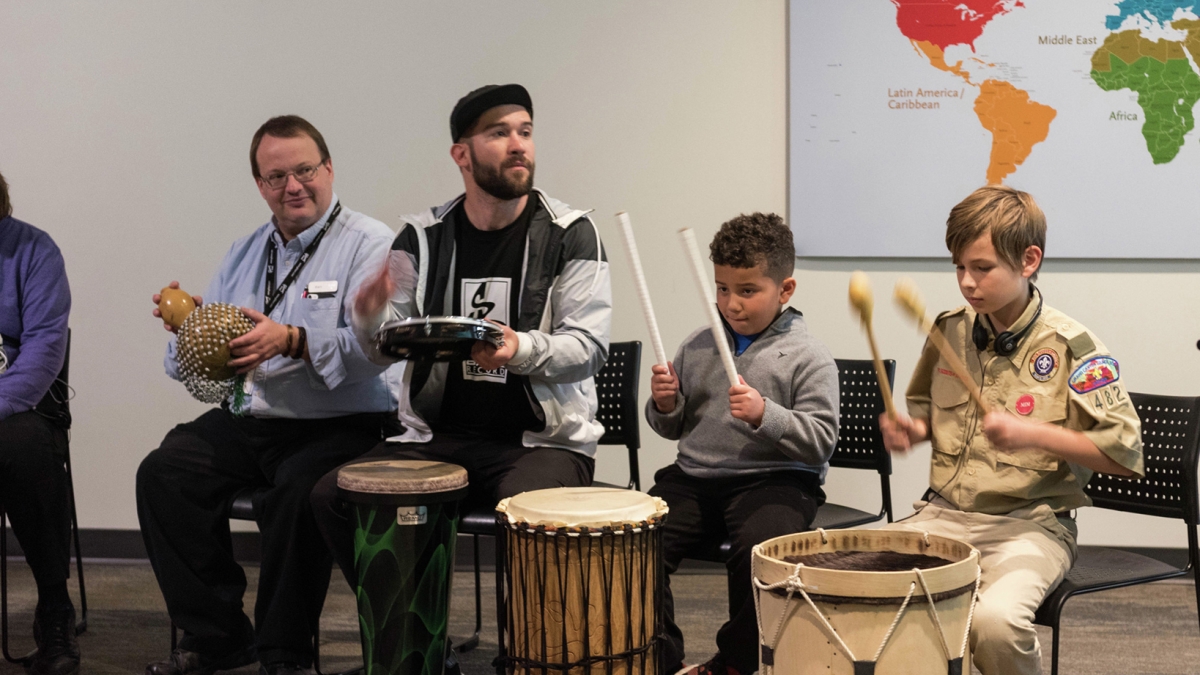Exploring how science and technology affect music-making
ASU School of Music faculty and staff engage public at the MIM

Visitors participate in a musical-instrument activity at the MIM on Jan. 20. Photo by Herberger Institute for Design and the Arts
Faculty, staff and alumni in Arizona State University’s School of Music in the Herberger Institute for Design and the Arts engaged students and community members of all ages at the Musical Instrument Museum in Phoenix on Jan. 20-21, to demonstrate how science can bring music to life. The School of Music presenters and performers pushed musical boundaries at the signature event and focused on how science and technology affect the way music is made and heard.
Garth Paine, associate professor in the School of Music and the School of Arts, Media and Engineering, and Simon Mancuso, faculty associate in the School of Music, performed “Metal Music.”
“The transforming experience of ‘Metal Music’ took the audience inside the sounds of metal objects,” said Paine. “The performance was a multifaceted experience of music and the science of resonance, featuring a wide range of custom-built instruments, including resonating cymbals, robots that played Tibetan singing bowls, metal percussion instruments, analog synthesizers and a digital re-synthesis process of live flute playing. The music was about texture and about sound quality. It was an experimental music performance focusing on the rich timbre of the sounds that can be produced by metal objects.”
Paine said those who attended experienced unfamiliar music in a complex, enticing sound world that was thick with texture, bringing attendees closer to sound as a material — like a sculpture in air.
Paine teaches the techniques within his Hybrid Ensemble class, his Advanced Interactive Sound class and in his composition lessons at ASU.
Samuel Peña, community engagement coordinator in the School of Music, facilitated an AZ Beat Lab workshop where attendees participated in a “community music jam,” consisting of six 30-minute jam sessions that utilized electronic drum machines, synthesizers and an array of percussion folklore instruments from around the world.
Peña said the workshop was about creativity, connecting with one another and exploring how electronic and world instruments can fit together with a group of people from all levels of experience.
“Through creating community, people build confidence within themselves and also confidence in their ability to connect with others,” said Peña. “One of my goals is to find ways for people to discover how the power of creating music in a community can help build relationships in a way that goes beyond the relationships that just words can do.”
Peña also participated in a collaborative session with Higher Octave Healing (HOH) and AZ Beat Lab that utilized the Ableton Live software program with a small group of pre-selected students. The session was part of a pilot program to explore ways in which music and technology can serve the sensory needs of students on the autistic spectrum.
HOH is a non-profit music therapy organization that is in partnership with the Music Therapy program in the ASU School of Music. Kymla Eubanks, who received her master’s degree in music from ASU in 2013 and is a faculty associate in the School of Music, is director of HOH.
Percussionist, composer and educator Jeremy Muller, who received a doctor of musical arts from the School of Music in 2012, performed several pieces in “Sonic Physiography” that showcased the interface between science and music, exploring music built on scientific and mathematical ideas that blend live acoustic playing and digital music.
Visit the School of Music’s “Community Music Lab” at ASU’s Open Door on Saturday, Feb. 24, from 1-6 p.m. in Zone A and explore a hands-on musical experience of music-making on an array of percussion and electronic instruments.
More Science and technology

ASU author puts the fun in preparing for the apocalypse
The idea of an apocalypse was once only the stuff of science fiction — like in “Dawn of the Dead” or “I Am Legend.” However…

Meet student researchers solving real-world challenges
Developing sustainable solar energy solutions, deploying fungi to support soils affected by wildfire, making space education more…

Miss Arizona, computer science major wants to inspire children to combine code and creativity
Editor’s note: This story is part of a series of profiles of notable spring 2024 graduates. “It’s bittersweet.” That’s how…